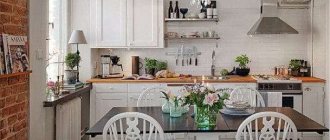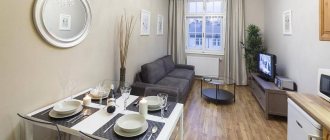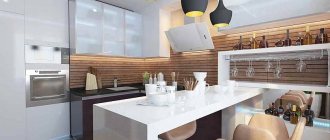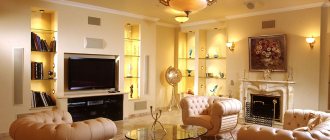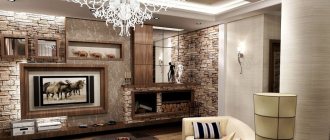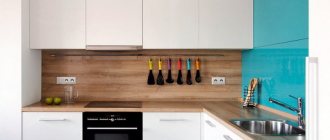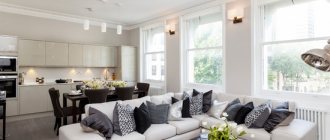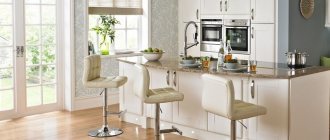One of the design solutions is to combine the kitchen with the living room, which is not so rare in our apartments and houses. On the one hand, this is convenient, but on the other hand, sometimes you still want the living room to be a full-fledged room, and the kitchen to be a kitchen designed for cooking, frying, and steaming. In such cases, dividing these two rooms as separate zones comes to the rescue, in other words, zoning.
You will learn about how to zone a kitchen in the article. You will learn useful design secrets.
Zoning the kitchen and living room with shelving
- divide the kitchen and living room between each other using such a familiar shelving unit . In addition to the fact that it will divide the work area and the relaxation area, it will also carry an additional functional load, being a useful space that can serve for storing things needed both in the kitchen and in the living room.
Rack
- The advantage of zoning the kitchen and living room with a shelving unit is that it is appropriate in any interior and style, since it can be made in completely different designs and colors. The additional space will be used to store books, dishes, toys, souvenirs on this “partition” - whatever you see fit.
- The rack is also convenient because it maintains coziness, carries a functional load, and does not look like a bulky part of the interior. But, unfortunately, he will not be able to prevent the smell from penetrating. And dust accumulates on it periodically - so there will be a little more cleaning.
How to zone a room into a kitchen and living room
To ensure that the interior design of the kitchen-living room does not cause inconvenience, and that two rooms with different purposes look harmonious, correct zoning and convenient arrangement of furniture will help. Original decor and well-placed accents will give the space a complete look and a feeling of unity. How can you zone a room into a kitchen and living room?
Furniture
Zoning the kitchen and living room with furniture is the simplest solution. Either a bar counter, a kitchen island, or a regular sofa is perfect for this purpose. Soft poufs, high shelves, and cabinets are also used for zoning. The main thing to remember is that all pieces of furniture should suit both rooms, visually unite them, and not create the feeling of two different rooms.
Lighting
Another option for effective separation is the use of modern lighting and original lamps. In addition, with the help of lighting design you can radically change the appearance of the room, creating a feeling of wow effect.
You can highlight the cooking area using lighting around the perimeter of the cabinets, or you can highlight the lower cabinets so that they appear hanging and as if floating in the air. If the upper cabinets have glass doors, then lighting can be built into them. In addition, all household appliances are also equipped with their own lighting, creating the effect of a high-tech kitchen.
The living room area can also be highlighted with ceiling lighting, oversized floor lamps and hanging sconces. Most often, multi-level ceilings are used for the living room and kitchen, making it easier to create a lighting design for zoning.
Multi-level floor
The podium can be used not only to disguise communications, but also to divide the room into functional zones. Such a solution can be implemented not only in a private house, but also in a kitchen combined with a living room in an apartment.
Moreover, you can raise both the kitchen area and the recreation area. The kitchen on the podium looks cozy and truly separate. And in the living room area, the podium can be made more functional, for example, covered with carpet and used as a place to relax. Or use the space under the podium as storage space.
Partitions
A partition between the kitchen and living room will be a more radical solution to highlight one of the zones. Moreover, the partition can be either stationary or mobile. To separate one space from another, wooden blocks, bamboo stems, screens, sliding glass doors, glass blocks, three-dimensional structures made of wood, metal, and plastic are used. It is necessary to choose a partition based on the general style and color scheme of both rooms. A kitchen-living room with a plasterboard partition, in which you can arrange storage niches, will also become a functional solution.
Decor and accessories
You can visually separate two rooms not only with the help of volumetric structures and stationary partitions. More mobile items that can be removed or replaced if desired are suitable for this purpose: large flower pots with large plants, curtains, soft pillows and poufs, rugs.
With the right approach, you will get a functional and beautiful kitchen-living room, the zoning of which will turn the room into a cozy corner where you can relax, work, and cook comfortably.
Wallpaper: kitchen-living room zoning
- One of the easiest ways to zone the kitchen and living room is to use various finishing materials, and first of all, wallpaper, which you will use to cover the walls of the kitchen and living room areas.
- For this, you can use your choice of different wallpapers, or the same texture, but different colors. For example, take wallpaper with imitation tiles, brickwork, stone for the kitchen, and wallpaper with silk-screen printing for the guest area . Another option is to take wallpaper that is the same color, but differs in patterns . In addition, wallpaper can be used as materials separating zones in combination with other techniques. So, for example, combining wallpaper with wall painting - the main thing here is to choose colors and patterns that are in harmony with each other.
- You can use the classic version. In the living room area, cover the walls with wallpaper, and in the kitchen area, where there is a much greater risk of staining the walls, lay out wall tiles. In this case, it is also necessary to observe the principles of combination and harmony of colors. The walls can also be decorated with photo wallpaper . The main rule for such a division is to correctly combine colors and shades so that they complement each other.
Zoning
Wallpaper separation
Window between kitchen and dining room
The hole in the internal wall between the kitchen and the dining room not only allows for the efficient serving of daily lunch or dinner, but also has a beneficial effect on the distribution of space in the house. This solution opens up the interior and allows free communication between host and guest.
A very interesting effect occurs when the design style of the kitchen, dining room or living room complement each other and form almost a single whole. This solution also promotes the free flow of light, in addition to a more pleasant dining environment.
Kitchen-living room interior: zoning
- The rules for interior design are based on the fact that it must be made in the same style. That is, if you have decorated the living room in a classic style , you should not equip the kitchen with a high-tech design.
- A living room made in ethnic style will absolutely not be combined with modern kitchen appliances, so it is better to store them not in plain sight, but in closed cabinets. The same applies to the color scheme - it is better to keep it uniform, and diversify the zones with shades that are a couple of tones darker in a smaller space.
- Zoning the kitchen and living room can add up to a long and fairly narrow space - in this case, place some of the furniture so that they are perpendicular to the length. And with the same technique you can divide the space into separate zones. This way you can put a partition, a bar counter, a rack, a screen, even a sofa or a dining table. You will achieve a double effect - you will zone the space and visually expand it.
Persistent
Sofa
Separation
Fencing off the kitchen from the living room
Usually the simplest solution is considered optimal: a work area is created in the kitchen, the floor of which is lined with materials that are resistant to temperature changes, humidity and pollution. And in the living room there is a dining area: they put a table and chairs, make sure that the interior looks beautiful and stylish.
Floor in kitchen and living room zoning
At the same time, zoning presupposes that space needs to be allocated, accents should be placed correctly, and care should be taken about colors and lighting. There are many ways to divide a room into two zones, a kitchen and a living room, and not all of them are as simple as the idea of separating the area with a partition.
Partitions for zoning the kitchen-living room space
- When zoning the kitchen and living room , take into account their size, without choosing bulky designs for small rooms, and also select the color scheme of the partition in accordance with the shades of the wall design.
- Among the options for partitions are sliding ones , which will help expand the room when open, and separate the area of noise and smells from the living room when closed. The partition can be a closet (or an open shelving unit), a decorative fence decorated with many elements, curtains or an artificial wall, or a screen.
Sliding
- What material is most suitable for a partition? Almost anyone! Glass block is good if the apartment is small in size and not very light, plasterboard is convenient for giving it any shape, wood will add warmth, and bamboo will add exoticism. Partitions made of MDF panels, plastic, textiles, and metal are convenient and popular.
Fragile design
- Among the original solutions are a bar counter , which also carries a functional load, a fireplace that can be built into a false wall, a phytowall made up of indoor flowers, columns or arches, stained glass and even an aquarium or TV. In addition, when partitioning the space, you can choose any shape: from a classic rectangle to curved lines, from diagonals to an arched solution.
Phytostena
Options for partitions for the kitchen-living room
Various options for partitions provide the opportunity to make the interior much more original and unique.
Sliding
When extended, they will create a spatial illusion and add space and light to the room, and when closed, they will act as a door and perfectly hide the separated area, isolate sound, reduce noise and prevent the penetration of odors when cooking. Sliding models are distinguished by a wide variety of designs; with this convenient option, you can not only easily divide or combine the kitchen and living room into one, but also give the interior a magnificent and slightly extravagant look.
The photo shows a sliding partition separating a small kitchen and living room.
Wardrobe partition
A through shelving up to the ceiling, thanks to its non-bulky appearance, does not overload the space, but on the contrary makes it much more spacious, lighter and more comfortable. In addition, in this type of partition, you can store books, souvenirs or any other decorative items.
Decorative
They can have a variety of shapes and inserts or be decorated with a variety of decorative elements. This type of zoning is a real work of art and allows you to set a special mood and style for the room.
Curtains
The simplest and most beautiful way, which is perfect not only for providing personal space, but also for hiding the desired part of the room from light.
False wall
Promotes proper planning of space and gives it a more neat, comfortable and uncluttered look. An artificial wall can also be decorated in an interesting way using various decor, shelves, light bulbs, lighting or niches.
The photo shows a living room combined with a kitchen with zoning in the form of a bright false wall.
Screens
This decor item is a great addition to any interior. The screen adds lightness, airiness, aesthetic appeal to the room and creates a comfortable and elegant design.
Kitchen living room rectangular - zoning
- The rectangular view of the kitchen-living room is very well suited for zoning , since it is very easy to divide it into zones: square, rectangular, and even fit a circle, oval or triangle into a square. And you can emphasize these zones by combining various finishing materials to decorate surfaces and walls, playing with colors and lighting and, of course, using different options for partitions.
- If you make one of the zones oval or, for example, round, then the remaining corners can be filled with decorative elements or flowers in beautiful outdoor pots. Be sure to take into account the harmony of the color scheme of both wall decoration and kitchen furniture, since color is also one of the elements of successful zoning. Sharp contrasting solutions should be avoided when it comes to the work area - calm, muted shades are appropriate here.
- a rectangular kitchen-living room with several lamps. For example, place spotlights above the work area and a chandelier above the dining area. You should also take care of the corners of the room - they should also be illuminated.
Zoning
Divide
Elements
Furniture
Zoning the kitchen and living room with a bar counter
- This is a very suitable solution for a small kitchen area - this way you save space for a comfortable work area and a spacious dining area. The bar counter is suitable for both small and spacious rooms. In addition, its big advantage is its versatility. In addition to dividing up space, the counter is a great work surface and a place to have a cup of coffee or a snack. The rack is made into a stationary one, but a mobile version on wheels is also quite possible.
Persistent
Divide
Stand and furniture
Bright accents
Bar counter
- The dimensions of the bar counter depend on the size of the space that needs to be zoned. Therefore, its dimensions can vary from half a meter to one and a half meters in width and length. And to save work space, you can build household appliances or cabinets into the rack.
- By the way, there are times when the decision to zone the kitchen and living room with a bar counter is not the best solution. This applies to those cases when family traditions include dinners at a large table, and not snacks on the run, if the house is inhabited by elderly people or small children who are simply inconvenient to sit at the bar counter.
Zoning the kitchen and living room with two windows
- The advantage of two windows is the presence of additional lighting effects and sufficient illumination. And for zoning a space, two light sources are actually a gift, because each of them can be played up, thereby emphasizing the purpose of a specific zone.
- By zoning the kitchen and living room, you can place the dining area between the windows, thus expanding the work space. A small bar counter would be appropriate here, and the main layout can be made into an island. By covering the floor with materials of different textures (or even making a podium for one of the zones), you will thereby highlight areas with different functions, but for practical reasons, it is better to cover the floor in the work area with linoleum or tiles.
- If there are two windows , partitions such as a screen, an arch, or a stained glass window will also help to delimit zones; lamps will be very helpful in zoning. If you want to arrange a soft corner in one of the zones, then place it opposite one of the windows. This arrangement of the sofa would be a very good solution if the windows are panoramic and the view from them is simply conducive to relaxation.
Zoning
With two windows
Two windows Separation
Sliding partitions for zoning the kitchen and living room
- The advantage of sliding partitions is that their lightness and airiness can both emphasize the boundaries of two zones, kitchen and living room, and smooth them out. They successfully divide the room, and besides, they are distinguished by their lightness and mobility (they can be quickly reinstalled), such partitions take up virtually no space, can serve as a decorative element, are easy to install and are made from a wide variety of materials.
- The advantage of installing a sliding partition is that, depending on whether it is closed or open, such a partition can either hide the working process of cooking from view when the kitchen, to put it mildly, is not in perfect order, or turn the kitchen into a dining room, where you can sit comfortably and there will be no need to scurry back and forth setting the table - everything will be at hand. A sliding partition made of glass and metal is installed to zone the kitchen and dining-living room.
- Such partitions can be roller, which facilitates the process of opening and closing. An interesting version of the partition is in the form of an accordion, combining sliding and hinged methods of opening the partition. The cassette design is more complex, which needs to be equipped quite thoroughly. It should be borne in mind that glass partitions visually enlarge the space, even blocking it.
Sliding Zoning
Sliding partition
Advantages and disadvantages
Dividing the room into a kitchen and living room has many advantages:
- It becomes possible to receive many guests at the same time.
- No need to go back and forth setting the table.
- There is no need to purchase a separate TV for the kitchen.
- Both household members and guests can watch the cooking if they wish.
- The woman will have her children in full view.
- Family members will be able to spend more time together.
There are many ways to divide rooms, which allow you to create an interior according to your tastes and preferences. But zoning also has disadvantages:
- with poor ventilation, odors “walk” freely around the apartment;
- you need to clean both the kitchen and living room more often;
- You won’t be able to relax in silence if someone is cooking.
Another disadvantage is the inability to privacy and the complete lack of personal space.
Ceiling zoning in the kitchen and living room
- Designers today actively advise installing in the kitchen-living room, in particular, stretch ceilings that are waterproof, easy to clean, and not saturated with odors. Their advantage is also that they are easy to install, do not require time to prepare the room for renovation, and are also available in a wide variety of colors and textures, which significantly expands the choice.
- Zoning the kitchen and living room can be done by using several (but not more than 3) shades for the design. The ceiling can be made in several levels, maintaining a height difference of about 10 cm. Another option is to connect sections of different colors or shades (and if the ceiling is not suspended, but made of plasterboard, then it can be simply painted in shades that match the overall color scheme. By the way, experts It is not recommended to choose contrasting colors for zoning with the ceiling - it is better to choose a couple of shades of the same color.
Division Zoning
Split the ceiling
Interior windows in the interior of the house
Interior windows in the wall visually expand the space and change the decor in the rooms for the better, which is why they are often used by interior designers.
However, these elements must be installed with caution and not blindly follow fashion. Interior windows that are poorly designed can ruin the interior. To prevent this from happening, it is recommended to follow a few simple rules:
- For high-tech style, designs made of aluminum profiles are best suited.
- When decorating classic interiors, it is recommended to use wooden frames.
- You always need to take into account the ratio of wall area and openings.
- When decorating rooms in country style, it is advisable to equip the windows with shutters. Shutters are perfect for this purpose.
- For large glazing areas, regardless of the type of profile system, dividing elements for internal light openings should be used - strips and other types of decorative layouts.
To help you choose the optimal model, there are programs that help you choose the design of an interior window, the photo of which can be combined with the future decor of the room. In this case, it is better to immediately seek help from interior designers who work with such software. If it is not possible to make an opening in the load-bearing wall, you can install an interior decorative window. This design can be fixed to the walls at any convenient time and does not require major construction work.
Zoning living room-kitchen-dining room
- Zoning a kitchen with a dining room and living room is one of the popular “dacha” options. And often the kitchen here can only be represented by a stove with a cabinet-cabinet (it also acts as a work surface), located in the far corners, away from the eyes. In this case of limited space, the living room and dining room can be represented as one functionally combined sector.
- The general principle of planning, if we are dealing with a combined space , is that the zone that is most popular and often used by all family members is highlighted first. If you like cozy family gatherings, where everyone has their own thing to do, but at the same time you are all together, then you should allocate a living room area.
- If you prefer to gather around a large table, focus on the dining area, highlighting it. Well, if “main life” takes place in the kitchen, emphasize it with a bright set, rich design, separating other zones in any way - color, material, partition.
- Using different colors, their shades and finishing materials, do not forget that the delimitation of space can also be done using different levels of the ceiling and arrangement, for example, a podium, which will highlight the areas of the living room, kitchen and dining room. You can separate these zones with arches and supporting columns.
Design of a small kitchen-living room with zoning
- Of course, a small area limits the owners in many ways, but a small kitchen-living room also has its advantages. By zoning the kitchen and living room , you thereby expand the area, and at the same time reduce the distances that you have to cover when setting the table in the living room. And the housewife will have the opportunity to spend time not just in the kitchen, but also with the whole family.
- But what to do with odors that will seep out from a small kitchen much faster and stronger? And cleaning will take longer, because the kitchen takes much more time to clean. Zoning is proposed to solve such problems. It can be done by laying multi-level floors or using different coverings for them, using lighting that will be brighter in the kitchen area and subdued in the living room area. Of course, a partition will come to the rescue - a transparent one, a screen, a rack, in a word, anything that does not take up much space. And even a dining table, not to mention a bar counter, can act as such a partition . You can use the same design in both parts, playing with colors and shades, the texture of the material.
- Very tiny kitchens (for example, in Khrushchev-era apartment buildings) can be separated from the living room area by an arch, which can be created by demolishing the wall between the room and the kitchen - this way you will expand the living room area, since it will merge with the former passage to the kitchen. The kitchen itself will thus turn into a kind of alcove niche, designed specifically for performing ordinary kitchen work.
Small
Mini
Dividing a small room
Zoning of the kitchen living room 12-15 sq. m
- A twelve-meter kitchen, divided into a work area and a relaxation area, can be planned in a triangle, which will save space. The “tops” are the stove, refrigerator and sink, and the eating area is placed in the center. Next, we place a work area and a relaxation area against the wall. You can place the set in the corner, and a living room will be formed in the free part.
- zone the kitchen-living room from 12 to 15 m2 using counters, furniture, partitions, shelving, as well as dividing zones using the color or texture of finishing materials. If the space needs to be visually expanded, it is better to choose light colors, and for the recreation area - a darker tone. This way you will separate the sectors without using up space for partitions.
- Ceilings, which can be decorated in different colors and from different materials, lamps, and, of course, a color scheme for decorating the space, will help to emphasize the division into zones, Moreover, we are talking not only about the color of the wallpaper, but also about “bright spots” in the form of pillows or paintings. On 12-15 squares you can bring to life almost any style and any layout.
Up to 12 sq.m
Stylish
Light
In brown tones Small
Lighting in the interior of the kitchen-living room
It is recommended to plan lighting in advance, before the renovation begins. It is important to decide where the work areas will be located and how many lamps are needed. It is necessary to take into account that a modern kitchen uses a large number of household appliances and provide sockets for each of them.
view album in new window
In addition to the main light source, it is recommended to provide additional lighting for the working surface. This can be done using spotlights or LED strip.
In the recreation area you can install floor lamps and wall sconces. It is important that the shape and design of the lamps are harmoniously combined with each other. You can diversify the interior with the help of decorative lighting.
view album in new window
For the work area, it is better to choose the most natural light possible. Therefore, it is worth stopping at cold light. For the dining area, it is better to choose warm lighting, which helps awaken the appetite and creates a warm, cozy atmosphere.
Zoning of the kitchen-living room 16, 17, 18 sq. m
- This is a spacious enough area to delimit zones, moreover, to also include a dining area. One solution is to use a bar counter. At the same time, the average family will be able to successfully sit at the dining table without being crowded.
- In general, the kitchen and living room should be zoned based on the amount of furniture that you plan to place on it. Consider all possible options on paper or in a special computer program, taking into account the location of each cabinet, drawer, chair in such a way that they do not interfere with free passage. Also, immediately plan where it will be more convenient to place the work area and where the rest area, especially since the area makes it possible to distinguish between them.
- If you use not only a partition in the form of a bar counter for zoning, but also play with shades of color and texture of finishing materials, then you will be able to create a coherent image with a certain contrast in different zones. It is good, for example, to use one calm, warm color in the design, but diversify it with bright spots - dishes, sofa pillows, napkins.
- Experts consider the best layout for a narrow 16-18-meter kitchen to be linear, in which first there is a dining area, and in the back there is a seating area. In addition, the kitchen set can go into the TV area of the living room, this emphasizes the integrity of the space while the zones will be demarcated.
Bright
Warm tone Bright
Above
Kitchen-living room 20, 25, 30 sq. m zoning
- Such an area is considered large enough to accommodate two different functional areas in which you can do different things, but at the same time feel like part of the family, actually being in the same room with the rest of the household. Moreover, such an area will also accommodate a dining area.
- zone the kitchen and living room in the general interior with an unusual finish, say, tiles with imitation stone, and if you want to emphasize the importance of this particular zone, then add a soft sofa to the usual kitchen set. In addition, the kitchen area must be in close proximity to each of the communications, because water is constantly needed for cooking, and kitchen electrical appliances must be constantly plugged in. Therefore, in such a sector it is necessary to provide a minimum of decorative elements so as not to destroy them when eliminating possible leaks or replacing sockets.
- It will divide the space, but will not protect the hostess from the family while preparing dinner, for example, a bar counter or shelving. Just like a sofa as a partition, the main thing is that it does not interfere with free passage from zone to zone.
- If the kitchen area requires one housewife to be in it, then the size of the dining room depends on the number of family members gathering at the table. Based on it, both the dimensions of the kitchen unit and the volume of the zone itself should be determined. Techniques for using color, the texture of finishing materials, height differences, lighting and other design solutions will help you get away from partitions.
Big
Zoning a large space
Bright accents
We share
Original ideas for partitions
Some unusual ideas used for partitions.
Bar counter
A counter connected to a wall or kitchen unit blends harmoniously with the rest of the decor or creates a bright and stylish accent that attracts all attention.
In the photo there is a bar counter that goes into the wall as a partition for the kitchen combined with the living room.
Fireplace
It is a rather elegant and stylish solution for decorating the space between the kitchen and living room. A fireplace built into a false wall allows you to radically change the environment and functionally divide the room. With this design you can achieve an unusual effect of visual unity.
Furniture (sofa, etc.)
A sofa or other furniture located in the middle between the kitchen and living room is the most convenient zoning option that does not require extra costs. Pieces of furniture will look as organic as possible and will not interfere with free movement in the room.
The photo shows a brown sofa as a partition in the interior of a modern living room combined with a kitchen.
Plants
A phytowall as a partition will bring freshness and a feeling of comfort to the atmosphere. A composition made up of plants will become a modern and alternative zoning element.
Zoning of the kitchen-living room 40 sq. m
- This is a large room that allows family members to be together as much time as possible, but at the same time it requires proper zoning of the kitchen and living room. To do this, you should consider the purpose of each zone and their connection to each other.
- For example, a sofa will help to maintain the openness of the space A wonderful space divider can be a bookcase, the shelves of which will be double-sided, or a three-dimensional screen
- A single color will tie all the zones together well, and a color accent in each zone will help separate them. The same effect will be produced by lamps: the same main ones in all zones, and additional built-in ones in places where more light is needed. Curtains can also be similar in texture, but differ in shades of color.
- cluttered due to many details , then in a kitchen-living room measuring 40 square meters, such cute little things, on the contrary, will help create a unified style. For example, you can link a glass aquarium in the living room with a glass bowl in the kitchen filled with stones from the river - this way the theme of the water world will act as a connecting element. And a few more bowls with fruit, but already wooden, on the kitchen shelves or partition rack will tie the space together with their shape.
Large space
Dividing a large room
Zoning the kitchen and living room with a plasterboard partition
- When zoning the kitchen with the living room, you should think about whether you will be changing the furniture. If you are completely satisfied with it, you are used to it and do not want to part with it, then in this case a plasterboard partition should be built, precisely adapting to the furniture. Even a less experienced owner can install a decorative partition made of plasterboard; the main thing is to be able to handle a jigsaw, which is used to make carvings.
- How to divide them depends on how much demand both rooms have in your family: make a small kitchen and a spacious living room, or vice versa, and perhaps you will like two identical parts of the room. By the way, if you demolished a wall to combine rooms, then it is not necessary to build a plasterboard partition in the same place where the wall was - you yourself will determine where it is most needed.
- Such a partition can be functional, serving as a shelf with dishes or souvenirs. You can also make a bar counter, arch, etc.
- This material is convenient because it is easy to install, combines well with various designs, has good sound insulation, and is also low cost. It should be taken into account that drywall does not have sufficient strength, darkens the room to a certain extent, is afraid of moisture, and also requires additional cladding.
Divide
With shelves
With an aquarium
Practical
From plasterboard
Zoning the kitchen and living room in a private house
- Experts recommend a “kitchen-living room” layout either in small houses to save space, or, on the contrary, in huge ones, where the area needs to be made comfortable from a functional point of view. Modern trends suggest spacious, at least visually, rooms, and combining a kitchen with a living room is especially popular in this direction, which is most acceptable to do in a private home.
- Two problems that arise in this case are the penetration of odors and a large accumulation of garbage in the kitchen during cooking, and therefore the need for constant cleaning. But they can be solved with the help of competent space zoning. The choice of methods for this in a private house is huge: this includes a bar counter, which can be made in any size, depending on the area of the premises, and the design of arches or beams, screens and other partitions , not to mention the use of ceilings and floors and various materials for wall decoration.
- In addition, other functional details can be added to the zoning elements of the kitchen and living room; for example, a screen can be successfully combined with a fireplace, which is unlikely to happen in an apartment, but will add additional coziness to the house. The living room area can also be highlighted with carpeting of any size.
In the house
In private
2 in 1
2 rooms
Window between kitchen and living room
Despite the fact that this trend of design in walls and window partitions quickly took root in our country, it quietly disappeared for some time. Perhaps this is due to the fact that such an interior, which combined a kitchen with some other room, resembled a canteen in a school or some other organization. This design made the home interior somewhat cold and uninhabited. But today, windows between the kitchen and living room (dining room) are returning to houses and apartments.
The window between the living room and kitchen allows you to organize communication between the owner of the house and guests.
A window between the dining room and kitchen, for example, allows for constant communication between guests and the owner of the house. Visually, both of these rooms will look quite spacious, so you will solve the problem of insufficient space. That is why it is recommended to decorate both the kitchen and dining room in the same style. This also applies to the chosen colors and shapes with which the walls, ceilings and floors will be finished. Don’t forget that the pieces of furniture should also be combined with each other. All this will create the effect of a single space, but at the same time it will unite 2 functionally different zones.
You may be interested in: How to choose the right curtains for a modern kitchen?
In addition to all of the above, it should be noted that in the case where there is no ordinary window in the dining room or kitchen, but there is one in the adjacent room, this design move allows natural sunlight to pass into the back room.
Zoning options for kitchen-living room
- When zoning the kitchen and living room, you should remember that it is not at all necessary to settle on two standard zones. You can, if space allows, add to them, for example, a bar area, and divide the kitchen area into two: for cooking and for eating.
- zone a room both visually, using lighting, materials for decorating walls, ceilings or floors, colors, interior decoration, and functionally - by directly dividing the space using furniture or architectural structures.
- Of course, the combination of these two zoning options is also beneficial. For example, you can highlight the kitchen area by separating it with a screen or bar counter, making a multi-level floor or ceiling, or designing the opening in the form of an arch.
- At the same time, you can use various lighting, play with colors and shades of finishing materials, their texture, create bright spots of color in each of the spaces, not to mention arranging furniture in such a way that it zones the space on its own. If you follow the same chosen design style, the room will look uniform and stylish.
Room
Sharing a room
To zones
Bright room
With yellow furniture
Zoning options
Designers recommend separating zones in a room using various techniques. Conventionally, we can distinguish: a place for cooking, a relaxation area, a place for eating.
If the space in the room allows, then you can also arrange a bar area. But even the smallest kitchens should have a working and dining part.
view album in new window
Various techniques can be used to divide a room into zones. In some interiors, space is allocated using finishing materials. They can differ not only in color, but also in texture. An equally interesting solution is the multi-level ceiling and lighting. This option is especially relevant for small spaces.
In spacious kitchens, separation using furniture is often used. To do this, choose island sets, which are located in the central part of the room. Instead, you can install a bar counter. It will separate the seating area and the cooking area. It is recommended to consider spot lighting above the counter. Even 2-3 additional lamps can transform the interior.
view album in new window
Zoning the kitchen and living room - original solutions
Let's start with the fact that combining a kitchen with a living room is an original solution. Its implementation can also be done in a variety of ways, depending on the size of the area and how many people will use such a space.
Smart division
Therefore, the main options for zoning the living room and kitchen will be the following:
- Divide the zones with a conventional boundary. This role can be played by the same screen or stand, false wall or folding table top, curtain or curtain, aquarium or TV.
- Visual zoning: techniques with floors and ceilings, lighting solutions, textured finishes or colors are used.
- Zoning the kitchen with the living room using furniture, for example, a sofa of any shape or a set of upholstered furniture installed between the two zones, usually with the back facing the kitchen. Or you can use a dining table, which will automatically add a third to the two main areas - the dining area.
- For eating, you can use not only tables, but also coffee tables, consoles, folding tables and shelves, and even large cabinets. Such solutions are especially relevant in small apartments, where this way space is saved and space is expanded.
- Household appliances, located, for example, on a rack, or built-in, or an aquarium dividing zones are also an example of an excellent original solution for zoning space.
Useful articles about design:
- Zoning a room into a bedroom and living room
- How to beautifully decorate a corridor with your own hands
- High-tech style in interior design
- Pop art style in the interior
- High-tech design in the interior
Sliding walls and mobile modules
Sliding walls are common in offices, but they can also look good in a residential building.
Sliding walls are commonly used in offices and are associated with them. The glass elements are high (to the ceiling), easily transmit light and move from place to place. They are built into special grooves, and the useful area, unlike most other methods, is not hidden at all.
White and brown kitchen-dining room
They help to instantly change the layout of the room: here there were two rooms separated by a glass wall, but the partition was pulled back - a single space was created.
Zoning the living room and kitchen in country style
Glass is used in different ways (depending on customer requests). It can be matte, transparent, colored, engraved, patterned, or even stained glass. To better imagine the effect, you should first look at photographs of rooms where different types of glass were used.
Original layout of the kitchen-living room
Zoning the kitchen-living room using an arch
